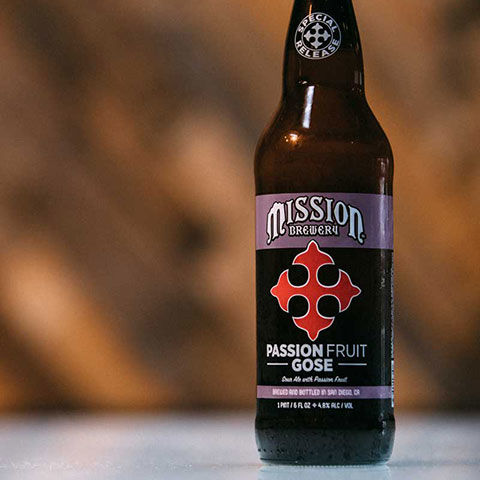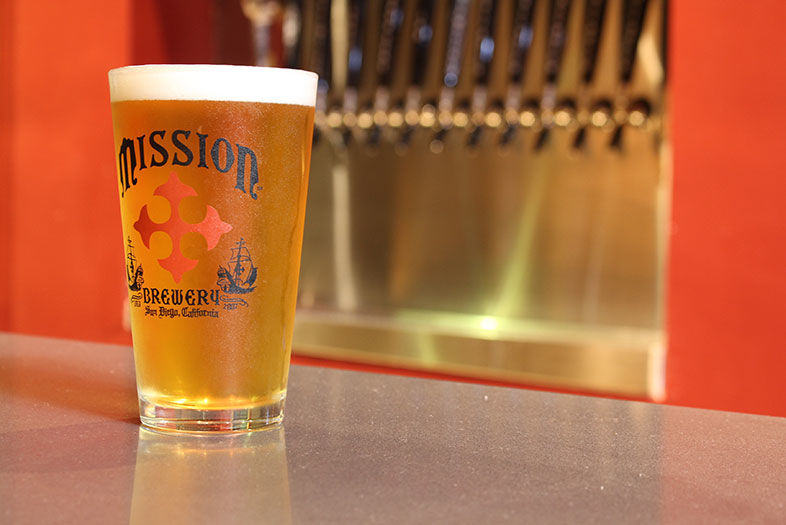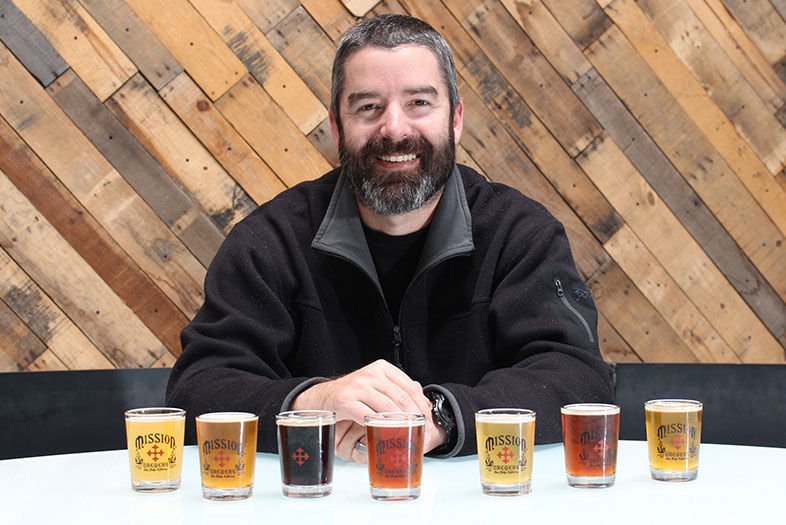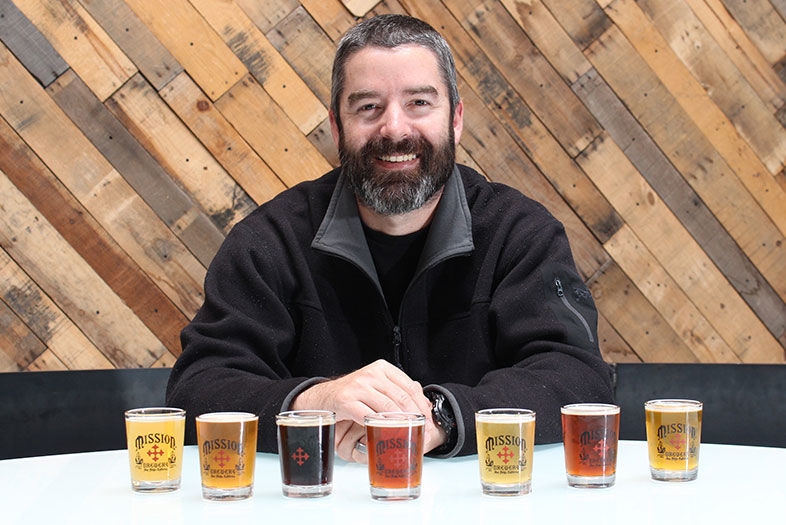I still recall the very first time I stepped foot inside the old Wonder Bread building on 14th and L street. It was like walking into an unfinished cathedral: 14,000 square feet of space and 23-foot bare-wood ceilings that glowed from the light coming in through skylights. I remember thinking to myself that this was the coolest new space I had seen for a brewery in San Diego, and there’s no way they’re going to be able to fill it all.
Flash forward six-and-a-half years to a view of that very same space: Now it’s packed to the rafters with fermentation tanks, a bottling and canning operation, a huge cold box, and tons of other supplies and equipment. They’ve even busted through the walls on all sides of the original space to add room for more offices, an expanded tasting room, and more production. Much of Mission’s success is due, in large part, to the bold vision of owner Dan Selis who, in turn, gives lots of the credit to his brewmaster, John Egan.
I sat down with John and asked him to reflect on what his journey has been like during the past (nearly) seven years, what new styles and techniques are exciting him, and what’s on the horizon for Mission in the future.
You came to Mission from Stone, right?
Yes. I worked at Stone from 2001 to 2010.
This space now, it’s such a dramatic contrast from 2010, when you first moved in. Do you remember what you produced that first year in terms of barrels?
That first year, I think it was 2,500 barrels or so. Now we’re in the 12,000–14,000-barrel range, which is a little bit less than last year, actually. We had kind of a weird situation with the root beer we were doing—that was such a trend. At one point it was a major part of our production, but it was here and then it was gone. And it was gone as fast as it got here. It was a fad.
What happened, do you think?
It was just a fad. People thought, “Oh, this is new and we want to try it.” And then everyone tried it and realized that it’s not beer! I mean, think about it, we’ve had beer and wine and spirits from the beginning of time, more or less. That’s what people go back to.
So, you guys are really back to being all about the beer at this point…
Yeah, we’re focused on beer. Shipwrecked (Double IPA) and Blonde are our two biggest core beers. And after that, it would be the Hefeweizen right behind those two.
What’s on the horizon for new stuff?
We’ve got a really cool plan that we’re following this year. The trend recently has been all about special releases—everyone always wants what’s next. So we’re focused more on that. Our new Fruit & Oak Series is part of that.
Will all those beers be fruited and barrel aged?

Have a Beer with Mission Brewmaster John Egan
Passionfruit Gose is the first in Mission’s Fruit & Oak Series. | Photo: Bruce Glassman
Fruited and/or barrel aged and fruited. For example, we’ve got the Passionfruit Gose now, and we did a mango-pineapple kettle sour (which is like a Gose, more or less). Everything’s made with real fruit, no extracts or anything. In the fall, we actually barrel-aged two beers that we did. We did a Big Berry beer, which was four or five berry purées that we added to a strong ale (kind of like a raspberry wheat on crack!—a high-alcohol version), and we aged some of that in fresh Elijah Craig barrels. We also did an orange vanilla porter; we took a porter, put a bunch of vanilla in it along with a bunch of blood orange purée, and then added peel and fresh zest. That was a draft offering in the fall and we also barrel aged some of that. Those two beers are going to be out following the Passionfruit Gose.
Fruited beers are definitely the hot trend right now.
I think it’s cool. These new trends are forcing brewers to get creative. Some brewers may think, “Oh, I never wanted to make beers like that,” but I think, “Hey, I can make a beer like that and make it really good.” So it’s kind of forcing us to do things that are maybe out of our comfort zone, which is a good thing. What I don’t personally care for is the fact that there are so many people leaning heavy on the extracts, which are artificial and processed. I don’t like that. Some of them are done well, but even the ones that are done well, I can’t get over it in my head that I’m drinking something with extracts. I mean, I like my fair share of carne asada burritos and junk food, but when it comes to beverages, I like water, coffee, beer, and spirits. That’s pretty much it.
What do you think are some of the greatest potential benefits of putting fruit in beer?
There are so many different options, obviously, and there are so many different fruits. Every once in a while you find one that has a flavor profile—I’m talking about the Passionfruit Gose specifically—where the passion fruit flavor is kind of funky, it’s got a kind of funk that reminds me a lot of the funk you find in brett beers or funky cheese. We‘ve been souring beers in the kettle for quite a while and we’ve gotten really comfortable with how we do it and how the beers turn out—every beer has turned out exactly the way we wanted it to and we haven’t had anything get “weird” or go in the wrong direction. While we were doing a bunch of kettle sours, I tasted some passion fruit juice that somebody had and I thought, “Oh, my god! I have to put this in beer! This is killer.” And so we made that beer. We brought together that fruit funk with the sourness from the lactobacillus in the kettle, which kind of mimicked brett, and I thought that was kind of cool. And when you start playing around like that, you realize there are lots of other flavors that can be brought into beer.
When you start playing around like that, you realize there are lots of flavors that can be brought into beer.
What are some of the pitfalls in working with fruit and beer?
Well, other than the problem where people are making a beer that’s too much about the fruit, probably the biggest pitfall is supply. I use Oregon Fruit products for most of my fruit needs, but they’re limited in what they have available. The passion fruit, for example, is seasonal.
How big a batch of something like that will you do?
We’ll usually do a 60-barrel batch.
And how much passion fruit will you need for that?
It’s a lot. It’s like four or five pounds per barrel, so you’re looking at 300 pounds of purée, which is also not cheap.
What about the whole New England-style craze? The hazy beers. Has that taken hold with you?
Yeah. When I first heard about it I was kind of like, “Meh. Whatever.” But we did a collaboration with Coronado Brewing on the island, at the brewpub. Our lead brewer, Bobby Oliver, and one of our brewers, Cody Morris, they went over there and did a SMASH beer, which is single-malt-single-hop, and they did it with that New England yeast. I think it was Pilsner malt and Mosaic hops. That beer was so good! We got a couple of kegs when it was done and they just disappeared. That beer was so awesome that it got me thinking, “You know what? I can see this.” There’s something about the haziness and the yeast in suspension, there’s more of an aroma blast and a richer mouthfeel. I think those beers are cool. There are those people who say, “IPAs need to be clear,” but we all know that if you hop the hell out of a beer—an IPA for example—it’s going to be hazy. It’s naturally going to be hazy, unless you over-filter it, but then you’re not going to have as hoppy a beer. So a hazy IPA that’s super fresh and super hoppy: I’m all for it. I don’t care as much about the look as the flavor. We haven’t used that yeast yet in house, but we are planning to very soon. I think it’s probably a trend that’s going to stay. Small brewers don’t typically filter many of their beers anyway and it’s one less step in processing the beer. It’s easier and it tastes fresher, so why not.

Have a Beer with Mission Brewmaster John Egan
Eff Cancer is one in a series of hop-bursted IPAs. | Photo: Bruce Glassman
Eff Cancer is one in a series of hop-bursted IPAs. | Photo: Bruce Glassman
Critics of the hazy beer craze say that making beers this way disregards the important traditions of beer making.
But that’s what we do. As brewers, we’re asked to be progressive. Regularly. I mean, West Coast IPA isn’t really traditional either.
Are there any other trends or new styles that you guys are playing with?
Well, we’re playing around with a few different things. We’ve got a Green Tea IPA coming, made with Sorachi Ace, which is kind of a funky hop. I’m looking forward to that. And we’re doing a bunch of hop-bursting, which is where you don’t add any hops for bittering [at the beginning of the boil]; we just overload it with hops at the end of the boil and then dry-hop to get bitterness and just a massive hop character. We’ve been doing hop-bursted beers for several months now, and we’re going to be doing a hop-bursted series. It’ll be draft only and they’ll all be IPAs in the 5% ABV area.
I assume you also cut way back on the malt bill for those beers.
That’s right. There are no crystal malts, only two-row. No darker malts. We don’t want to bring any of that flavor profile to the beer. That’s another thing I see as a big trend in IPAs and hoppy beers within the past six months: ditching the crystal malts, which also tend to show the oxidation sooner.
Looking back over the past six or seven years, how do you feel your style and Mission’s identity have changed or evolved?
When we started, it was a different landscape as far as beers go. We had our blonde, amber, IPA, hef, and Shipwrecked. Then I added the Dark Seas Imperial Stout and then the Imperial Red and the El Conquistador [extra pale]. Recently, we’ve started getting access to a bunch of new hop varieties, so that’s meant we’ve made some changes with our beer. Mission IPA, for example, has been reformulated. It’s delicious. It’s now Simcoe and Mosaic. It used to be Centennial and Cascade, so it’s totally different. I feel like the progression has been toward kind of getting the handcuffs off—we’re able to play around with different styles and we’re selling a lot of these new beers. The other thing is that I’ve got an awesome team of really talented guys—guys who are really into beer. And they’re the next generation. I’m the old guy. If I didn’t have those guys bugging me about trying new things or trying new hops, we may not have done that. So I’m heavily influenced by the younger generation. And my role here—the next stage in my career—is all about giving it back to these guys in every way that I can. It’s partly because I feel like I’ve been able to do almost everything I wanted to do. I’ve had my fun. Now I want to teach these guys everything that I can so that they’ll be able to, at some point, take the leap and become a head brewer somewhere else or even open up a brewery of their own.

Have a Beer with Mission Brewmaster John Egan
PARTNER CONTENT
Mission Brewmaster John Egan | Photo: Bruce Glassman















